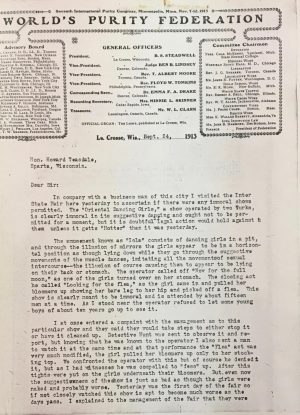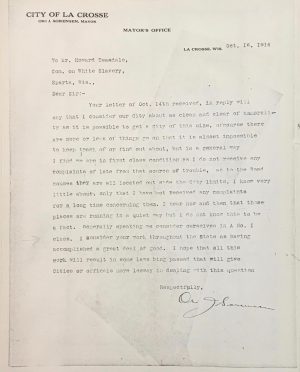Explained: The history of prostitution in La Crosse and its connection to “the Brothel Law”
December 31, 2020
For the University of Wisconsin-La Crosse students living off-campus, there is a law that prohibits six or more unrelated women from living in a household together. This is a semi-colloquially known law and one that dates back many years. The law, while originally believed to have a foundation in sexism, is today a universal law that landlords around the La Crosse area abide by. However, to better understand the systems of beliefs that allowed its creation, The Racquet Press conducted research on how this law was founded and the history behind it.
According to the La Crosse Municipal Code of Ordinances Article lV Section 115-146, “No building or land shall be used and no building shall be hereafter erected or structurally altered, except for the following uses, including uses customarily incidental to any of the permitted principal uses: Multiple dwellings; boardinghouses, rooming houses, fraternities and sororities occupied by less than six persons.”
This municipal code also tells some of the prostitution history of La Crosse. Although it is unclear whether this municipal code is a result of prostitution and brothels in La Crosse, the history of prostitution in La Crosse remains.
Courtesy of the UWL Murphy Library Special Collections, the La Crosse City ordinances from 1891 include sections on unlawful prostitution. Section five of the 1891 ordinance says, “Any person who shall solicit or procure another to visit or become an inmate of a house of ill-fame, for the purpose of prostitution or lewdness and any common prostitute or lewd woman who shall walk or be upon any street or public thoroughfare in this city, in the nighttime, or who shall walk the streets of said city for the purpose of plying her vocation, shall be punished by a fine.”

In addition, section eleven of the 1891 ordinance says, “Any person who shall appear in a public place in a state of nudity, or in a dress not belonging to his or her sex, or in indecent or lewd dress, or who shall make any indecent exposure of his or her person, or be guilty of lewd and indecent behavior, or who shall exhibit or offer to sell any indecent or lewd picture, book or other thing, or shall perform any indecent or lewd act or representation, shall be punished by a fine.”
Criticism surrounds these ordinances by the means of interpretation and vagueness. Many believe that women during this time were over-prosecuted and unfairly arrested. “The evidence does show that prostitutes and women accused of being prostitutes did suffer at the hands of an unsophisticated legal system which allowed arrest and conviction based on the slimmest of circumstantial evidence,” said Milton G. Gehles in his seminar paper “Prostitution in La Crosse Between 1876 and 1913”.
During a hearing before the Wisconsin Legislative Committee on white slavery in La Crosse on Jan. 7, 1914, then County Judge John Brindley gave a statement. When he was asked if he requires an officer to have overheard words directly soliciting the man, Brindley said, “I think if I depended upon that for a conviction, I would require it, but they can be convicted without that. For instance, if they have been drinking and hanging about places where intoxicating liquors are sold, and also have a general reputation of being prostitutes, I think it is sufficient, without any direct solicitation.”

That same year, Mayor Ori Sorensen said, “I consider our city about as clean and clear of immorality as it is possible to get a city of this size, of course, there are more or less of things [that] go on that it is almost impossible to keep track of or find out about.” This was written in a letter commenting on the Wisconsin Legislative Committee. “As to the Roadhouses they are all located outside the city limits, I know very little about, only that I have not received any complaints for a long time,” said Mayor Sorensen. This account was retrieved by the UWL Murphy Library Special Collections.
In the late 19th-century and early 20th-century prostitution in La Crosse was part of the city’s life. According to Sanford and Hirshheimer’s book The History of La Crosse, many laws were imposed as a result to keep “immoral behavior” out of La Crosse. One of these laws, passed in 1886, included that anyone found to be working on a Sunday would be arrested.
The history of La Crosse does not always define its future. The city ordinance prohibiting more than six unrelated people from living together may be grounded in antiquated beliefs, however, it could exist for other reasons. Regardless, there is no “brothel law” in La Crosse and no legal reason to prevent the coexistence of more than six women, or men, in the same household. The historical roots of prostitution may have defined the realities of the city policy once, but they have no place in the contemporary ordinance that defines housing situations for many today.






